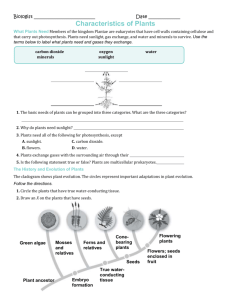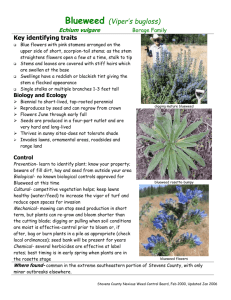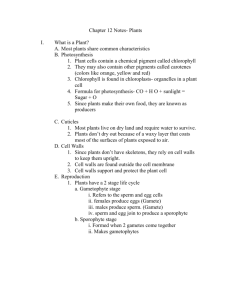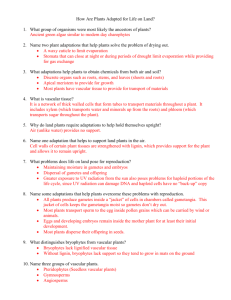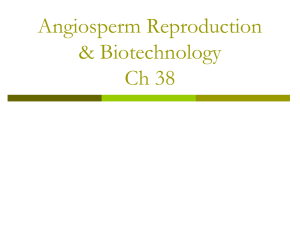The Plant Life Cycle
advertisement
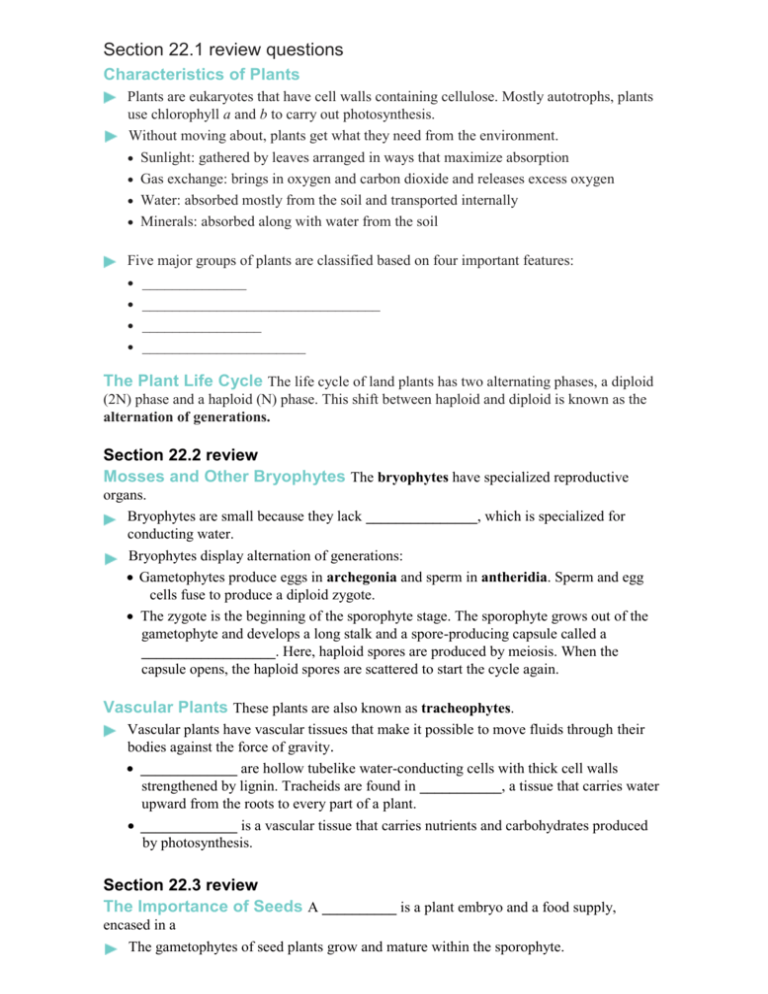
Section 22.1 review questions Characteristics of Plants Plants are eukaryotes that have cell walls containing cellulose. Mostly autotrophs, plants use chlorophyll a and b to carry out photosynthesis. Without moving about, plants get what they need from the environment. Sunlight: gathered by leaves arranged in ways that maximize absorption Gas exchange: brings in oxygen and carbon dioxide and releases excess oxygen Water: absorbed mostly from the soil and transported internally Minerals: absorbed along with water from the soil Five major groups of plants are classified based on four important features: ______________ ________________________________ ________________ ______________________ The Plant Life Cycle The life cycle of land plants has two alternating phases, a diploid (2N) phase and a haploid (N) phase. This shift between haploid and diploid is known as the alternation of generations. Section 22.2 review Mosses and Other Bryophytes The bryophytes have specialized reproductive organs. Bryophytes are small because they lack _______________, which is specialized for conducting water. Bryophytes display alternation of generations: Gametophytes produce eggs in archegonia and sperm in antheridia. Sperm and egg cells fuse to produce a diploid zygote. The zygote is the beginning of the sporophyte stage. The sporophyte grows out of the gametophyte and develops a long stalk and a spore-producing capsule called a __________________. Here, haploid spores are produced by meiosis. When the capsule opens, the haploid spores are scattered to start the cycle again. Vascular Plants These plants are also known as tracheophytes. Vascular plants have vascular tissues that make it possible to move fluids through their bodies against the force of gravity. _____________ are hollow tubelike water-conducting cells with thick cell walls strengthened by lignin. Tracheids are found in ___________, a tissue that carries water upward from the roots to every part of a plant. _____________ is a vascular tissue that carries nutrients and carbohydrates produced by photosynthesis. Section 22.3 review The Importance of Seeds A __________ is a plant embryo and a food supply, encased in a The gametophytes of seed plants grow and mature within the sporophyte. The _____________ are seed plants that bear their seeds directly on the scales of cones. The _______________ are seed plants that bear their seeds in flowers inside a layer of tissue that protects the seed. In seed plants, the entire male gametophyte is contained in a tiny structure called a pollen grain. The sperm are produced inside pollen grains and do not have to swim. Pollen grains are carried to female reproductive structures by wind or animals. The transfer of pollen from the male reproductive structure to the female reproductive structure is called ________________. After fertilization, the zygote in the seed grows into a tiny plant—the sporophyte embryo. A tough seed coat surrounds and protects the embryo and keeps the contents of the seed from drying out. Section 22.4 review Flowers and Fruits Angiosperms reproduce sexually by means of flowers. Flowers contain ovaries, which surround and protect the seeds. ______________ means “enclosed seed.” Flowers are an evolutionary advantage because they attract animals that carry pollen with them as they leave flowers. After fertilization, ovaries within flowers develop into fruits that surround, protect, and help disperse the seeds. A fruit is a structure containing one or more matured ovaries. For many years, angiosperms were classified according to the number of seed leaves, or cotyledons. ___________ have one seed leaf. ___________ have two seed leaves. Plants are also grouped by the characteristics of their stems. ________________ have stems that are made primarily of cells with thick cell walls that support the plant body. Section 22.1 questions For Questions 1–8, write True if the statement is true. If the statement is false, change the underlined word or words to make the statement true. 1. Both grasses and mosses are examples of plants. 2. Green algae are now considered to be protists. 3. Most plants are either parasites or saprobes. 4. In plants, chlorophyll a and b are located in chloroplasts. 342 Name Class Date 5. Besides oxygen, plants need water and carbon dioxide for photosynthesis. 6. Plants require oxygen for cellular respiration. 7. Land plants evolved with structures that promote water loss. 8. Plants usually take in water and minerals through their leaves. The History and Evolution of Plants For Questions 9–12, complete each statement by writing the correct word or words. 9. The ancestors of land plants lived in . 10. The oldest fossils of land plants are roughly years old. 11. The greatest challenge faced by early land plants was obtaining . 12. Early land plants obtained enough water because they grew close to the ground in places. The Plant Life Cycle 16. What is the shift between haploid and diploid phases in the sexual life cycle of a plant called? 17. Complete the diagram below by writing the name of each phase in a plant’s life cycle. Also indicate whether the phase is haploid (N) or diploid (2N). The Plant Life Cycle Spores (N) Plant (______________________) Plant (______________________) Sperm (N) Eggs (N)
